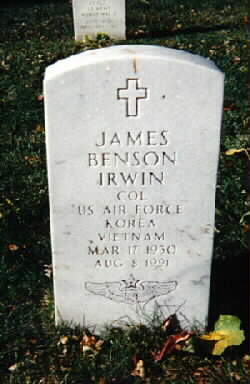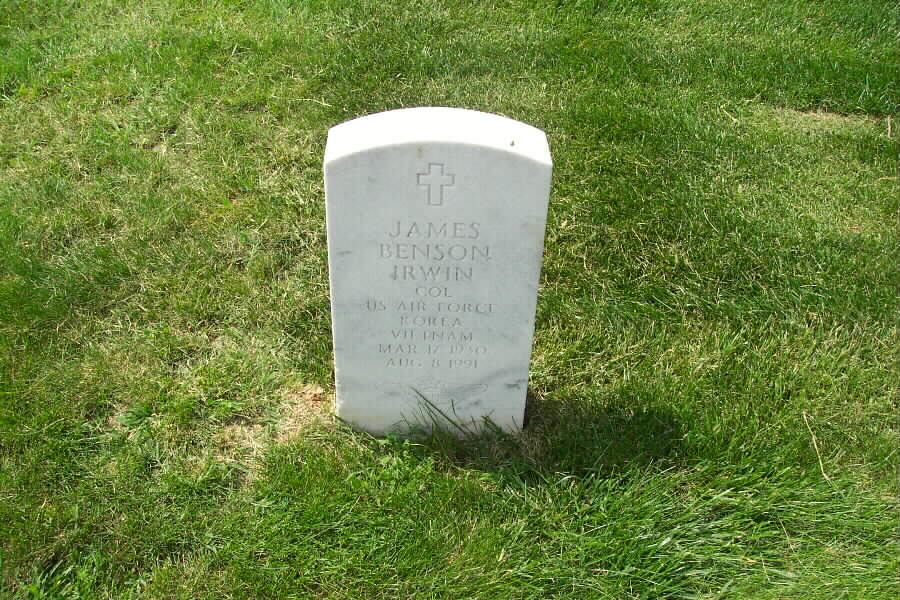From a contemporary news report:
“James Irwin, an astronaut who walked on the moon in 1971 and later founded an evangelical religious organization, died at Valley View Hospital in Glenwood Springs, Colorado. He was 61 years old and lived in Colorado Springs. A hospital spokesman said that he died of an apparent heart attack.
“Irwin said that it was his experience exploring the moon on the Apollo 15 mission in July 1971 that moved him to devote the rest of his life to “spreading the good news of Jesus Christ.” He resigned from the Astronaut Corps a year later and became the founding president of the High Flight Foundation, and inter-denominational evangelical organization based in Colorado Springs. To church groups aroung the counry, he often spoke of the lunar mission as an epihany, declaring “I felt the power of God as I've never felt it before.” While on the moon, at the end of the first day exploring the rugged lunar highlands, he said he was reminded of “my favorite Biblical passage from Psalms.” Speaking by radio to Mission Control in Houston, he began quoting the passage, “I'll look into the hills from whence cometh my help,” and added quickly, “but, of course, we get quite a bit of help from Houston, too.” The remark was typical of the seriousness and awe with which he, then a Lieutenant Colonel in the Air Force, approached the task of exploring the moon, ad well as the enthusiasm and good humor that he convyed throughout the mission. He and Colonel David R. Scott of the Air Force were the 7th and 8th Americans to walk on the moon. It was his only space mision.
He establised High Flight with his pastor, Reverend William H. Rittenhouse, a Baptist. The organization operates religious retreates and tours to the Holy Land. In addition to traveling widely and making speeches to make money for High Flight and to share his experiences as an astronaut and a devoted Christian, he wrote a book on the experiences, “To Rule The Night.” On two occasions he led expeditions to Mount Ararat in Turkey in search of Noah's Ark. In 1982, he reached the 16,946-foot summit but fell on the glacier, suffering severe leg and face lacerations. He had to be carried down on horseback. A year later, he surveyed the summit by airplace, looking down for possible remains of the Ark, which according to the Book of Genesis, came to rest on the mountains of Ararat. “It's easier to walk on the moon,” he said. “I've done all I possibly can, but the Ark continues to elude us.”
He had known accidents and injury before. Ten years before his Apollo mission, his plane crashed on a routine training mission, leaving him with two broken legs, a broken jaw and a concussion that wiped out his memory. It took extensive psychiatric treatment and hypnosis to restore his memory and enable him to resume flying, 14 months later. While on the moon, he and Scott experienced brief spells of irregular heart rhythm, probably the result of extreme fatigue. Less than two years later, at age 43, he suffered a heart attack while playing handball. Since then he had developed a history of heart problems. Space Agency doctors said they doubted that the attack could have been attributed in any way to his space flight. They noted that pre-flight testing had shown him to b prone to slight uneven heartbeats on occasion after exercise.
“Born March 17, 1930 at Pittsburg, the eldest son of a plumber, the family moved to Florida then to Salt Lake City, where he attended High School. The family later moved to San Jose, California, where he met the woman he would later marry, Mary Ellen Monroe, a photographers's model. His mother wanted him to be a preacher, but a brief rid in an old barnstorming plane when he was four years old had turned his mind to flying.
After graduation from the United States Naval Academy in 1951, he was commissioned an officer in the Air Force but his request for pilot training was turned down. He spent several years at military desk jobs before he was finally admitted to Air Force Test Pilot School. he also earned a Master's Degree in aeronautical engineering at the University of Michigan in 1957. He first applied to be an astronaut in 1964, but was rejected twice before being accepted in 1966. On the Apollo 15 mission, he and Scott were the first astronauts to use the battery-powered 4-wheel runabout, Rover 1, in moving about on the lunar surface. This enabled them to collect 175 pounds of rocks and soil from widelyscattered sites near lunar Appennine Mountains. The third member of the crew, Major Alfred M. Worden, piloted the Apollo Command Module in lunar orbit while the other two were on the surface. Their accomplishments were marred bu the disclosure that the three astronauts had smuggled 400 specially stamped and cancelled envelopes on the mission in an arrangement with a West German stamp dealer. A share of the proceeds from the sale of these souvenirs was to be set aside as trust funds for their children. NASA reprimanded the astronauts for exercising poor judgement and they never realized any money from the arrangement. Before the reprimand, he had already
announced his plan to retire from the Air Force and to resign from the spavce agency. In addition to his wife, he was survived by his mother, Elsa Irwin, and five children.”
He was buried in Section 3 of Arlington National Cemetery.
Michael Robert Patterson was born in Arlington and is the son of a former officer of the US Army. So it was no wonder that sooner or later his interests drew him to American history and especially to American military history. Many of his articles can be found on renowned portals like the New York Times, Washingtonpost or Wikipedia.
Reviewed by: Michael Howard


